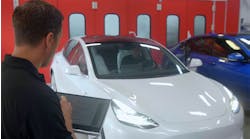The National Highway Traffic Safety Administration (NHTSA) opened a formal safety defect investigation of the Chevy Volt last November. After several crash tests, the vehicle’s lithium ion battery revealed signs of fire hazards after a severe collision.
The initial fire occurred in May after the NHTSA’s 22 mph side-pole crash test during the Volt’s New Car Assessment—a test designed to measure the vehicle’s ability to protect occupants from injury. The test earned NHTSA’s five-star safety rating for the Volt, but also resulted in a battery fire more than three weeks later.
Rob Peterson, Chevrolet’s Volt spokesman, says that initial fire prompted the NHTSA to conduct three subsequent tests in November, in conjunction with General Motors (GM) and the U.S. Energy and Defense departments. The NHTSA intentionally damaged the Volt’s lithium ion battery compartment and ruptured its coolant line. Each test impacted and rotated the battery to simulate a side impact collision followed by a rollover.
NHTSA conducted the first test Nov. 16, 2011 without a fire. The second test, conducted Nov. 17, 2011, caused the battery to increase in temperature, which resulted in a fire one week later. The third test, on Nov. 18, 2011, caused the battery to smoke and emit sparks within hours.
Peterson says these fires are caused when there’s an intrusion in the vehicle’s lithium ion battery pack and coolant is able to leak inside. The coolant sloshes around inside the battery casing when it’s rotated during a rollover. That causes the battery’s cells, circuit boards and controls to short out and trigger a fire.
But Peterson says these fires were only caused because the Volt’s battery was left full of energy and powered on after the tests.
“The NHTSA did not drain energy from the battery after conducting the tests,” Peterson says. “Most likely, we would not have experienced an issue had that been done. No Volt to date has shown risks of fire hazards when the battery is handled properly.”
That’s the exact precaution repairers need to be aware of. Electric vehicles are safe, as long as you know how to deal with their batteries following collisions.
For the time being, GM is getting involved directly when there’s an accident involving a Volt. Each vehicle is equipped with On Star, so GM knows immediately after collisions occur. Peterson says the company is sending engineers out to depower Volt batteries after collisions in order to capture and analyze information. He says shop operators should ask customers whether the manufacturer was notified if they bring a damaged Volt to your shop.
But this isn’t just an issue concerning Volts. You need to be cautious with any other vehicle that uses a lithium ion battery: the Ford Focus, Nissan LEAF, Tesla Roadster, Hyundai Sonata, Kia Optima, Mercedes S400 and BMW ActiveHybrid 7. Electric vehicle expert and trainer Craig Van Batenburg, CEO of the Automotive Career Development Center (ACDC), says there are a few precautionary tips that should become standard in your shop’s electric vehicle procedures immediately after one shows up at your facility:
- Depower the lithium ion battery.
- Disconnect the 12-volt battery. Van Batenburg says elctric vehicles have a small 12-volt battery that warms and cools the lithium ion battery. Cables connected to that 12-volt battery need to be cut to power down the vehicle.
- Remove the service disconnect. On the Volt, the service disconnect is an orange-colored plug located inside the center console. Peterson says removing the service disconnect isolates the power in the battery from the vehicle. The battery still has energy, but it won’t run through the vehicle.
- Move it to a safe location outside. Take extra precaution to ensure any fire does not occur inside your facility, Van Batenburg says. Keep the vehicles in a corner of your parking lot at least six feet away from other objects. This is especially important for totaled vehicles because those are the most likely to have an issue.
- Deal with the car immediately. Do not leave the vehicle sitting in your parking lot untouched until the repair begins. Precautionary procedures should be done immediately after the vehicle arrives to your facility, Van Batenburg says. You never know if or when a problem might occur, so you need to proactively prevent it from happening.


